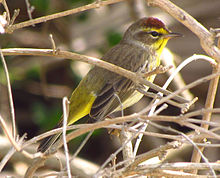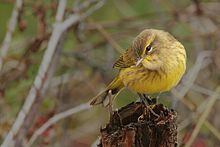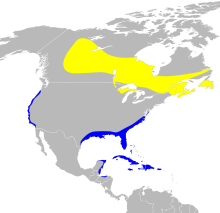Palm warbler
| Palm warbler | |
|---|---|

| |
| "Brown" palm warbler in breeding plumage | |

| |
| "Yellow" palm warbler in non-breeding plumage | |
| Scientific classification | |
| Kingdom: | |
| Phylum: | |
| Class: | |
| Order: | |
| Family: | |
| Genus: | |
| Species: | S. palmarum
|
| Binomial name | |
| Setophaga palmarum (Gmelin, 1789)
| |

| |
Breeding range Wintering range
| |
| Synonyms | |
|
Dendroica palmarum | |

The palm warbler (Setophaga palmarum) is a small songbird of the New World warbler family.
Taxonomy
The species comprises two distinct subspecies that may merit specific status.
"Yellow palm warbler" or "eastern palm warbler" (S. p. hypochrysea) of the eastern third of the breeding range has brownish-olive upper parts and thoroughly yellow underparts with bold rufous breast and flank streaking. It migrates later in the fall than its western counterpart.
"Brown palm warbler" or "western palm warbler" (S. p. palmarum) inhabits the remaining western two-thirds of the breeding range. It has much less yellow below, with less colorful streaking, and cold grayish-brown upper parts.
Distribution
Palm warblers breed in open coniferous bogs and edge east of the Continental Divide, across Canada and the northeastern United States.
These birds migrate to the southeastern United States, the Yucatán Peninsula, islands of the Caribbean, and eastern Nicaragua south to Panama to winter.[2] They are one of the earlier migrants to return to their breeding grounds in the spring, often completing their migration almost two months before most other warblers.
Palm warbler has been recorded as a vagrant to Iceland.[3]
Behavior
Palm warbler nests take the form of an open cup, usually situated on or near the ground in an open area.
Palm warblers forage on the ground much more than other warblers, sometimes flying to catch insects. These birds mainly eat insects and berries. Their constant tail bobbing is an identifying characteristic. Kirtland's, prairie, and palm warblers are the only Setophaga species that incessantly bob their tails.
The song of this bird is a monotonous buzzy trill. The call is a sharp chek.
References
- ^ Template:IUCN
- ^ "Palm Warbler". All About Birds. Cornell Laboratory of Ornithology. Retrieved 2008-10-12.
- ^ Þráinsson, Gunnlaugur (1997) Palm Warbler and Cerulean Warbler in Iceland - new to the Western Palearctic Birding World 10(10): 392-393
External links
- Palm warbler - Dendroica palmarum - USGS Patuxent Bird Identification InfoCenter
- Palm warbler species account - Cornell Lab of Ornithology
- Stamps (for British Virgin Islands) at bird-stamps.org
- "Palm warbler media". Internet Bird Collection.
- Palm Warbler photo gallery at VIREO (Drexel University)

